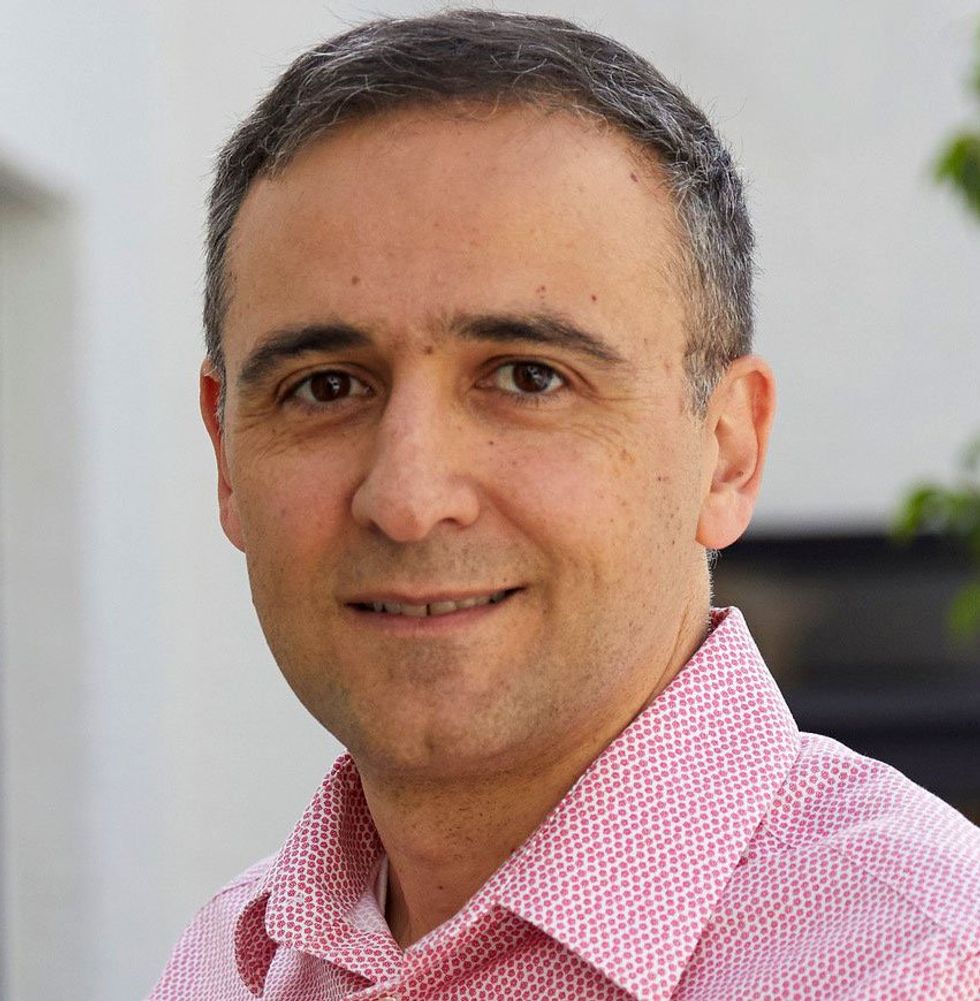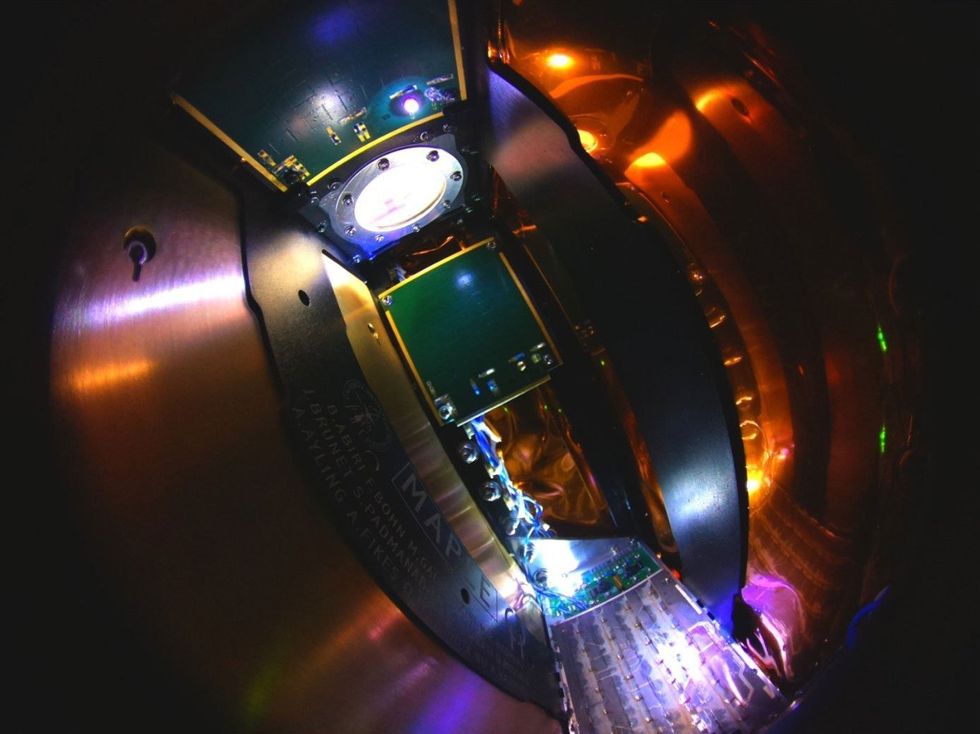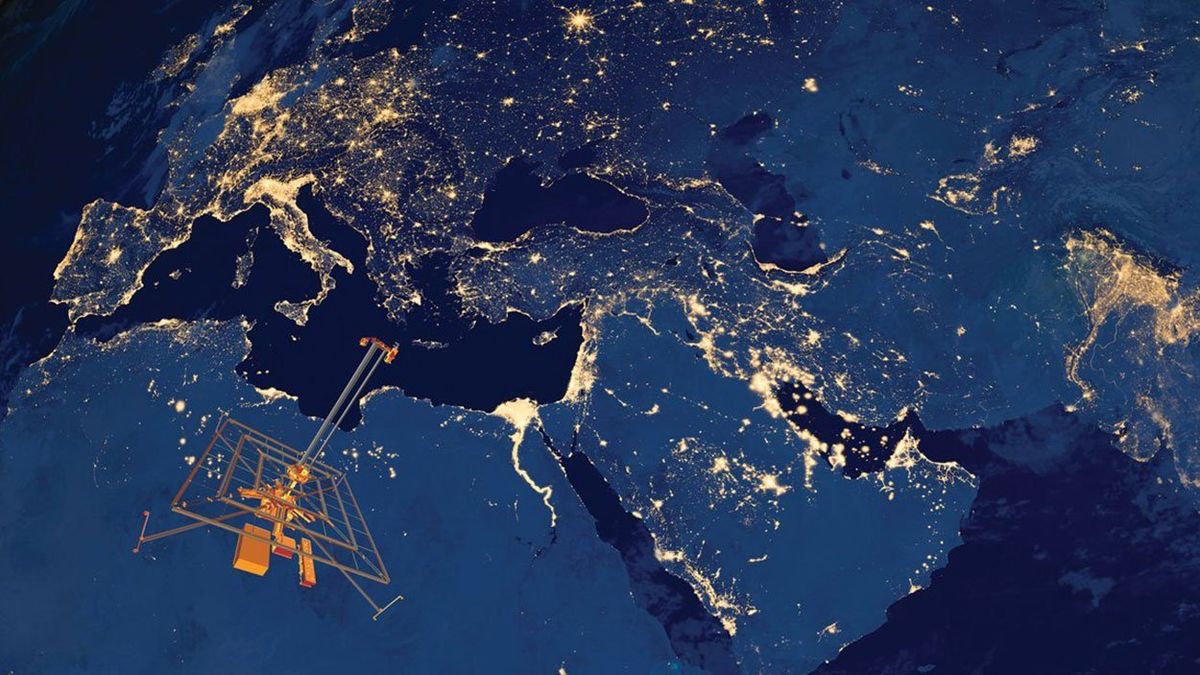The idea of powering civilization from gigantic solar plants in orbit is older than any space program, but despite seven decades of rocket science, the concept—to gather near-constant sunlight tens of thousands of kilometers above the equator, beam it to Earth as microwaves, and convert it to electricity—still remains tantalizingly over the horizon. Several recently published deep-dive analyses commissioned by NASA and the European Space Agency have thrown cold water on the hope that space solar power could affordably generate many gigawatts of clean energy in the near future. And yet the dream lives on.
The dream achieved a kind of lift-off in January 2023. That’s when SSPD-1, a solar space-power demonstrator satellite carrying a bevy of new technologies designed at the California Institute of Technology, blasted into low Earth orbit for a year-long mission. Mindful of concerns about the technical feasibility of robotic in-space assembly of satellites, each an order of magnitude larger than the International Space Station, the Caltech team has been looking at very different approaches to space solar power.
For an update on what the SSPD-1 mission achieved and how it will shape future concepts for space solar-power satellites, IEEE Spectrum spoke with Ali Hajimiri, an IEEE Fellow, professor of electrical engineering at Caltech, and codirector of the school’s space-based solar power project. The interview has been condensed and edited for length and clarity.
SSPD-1 flew with several different testbeds. Let’s start with the MAPLE (Microwave Array for Power-transfer Low-orbit Experiment) testbed for wireless power transmission: When you and your team went up on the roof of your building on campus in May 2023 and aimed your antennas to where the satellite was passing over, did your equipment pick up actual power being beamed down or just a diagnostic signal?

Ali Hajimiri: I would call it a detection. The primary purpose of the MAPLE experiment was to demonstrate wireless energy transfer in space using flexible, lightweight structures and also standard CMOS integrated circuits. On one side are the antennas that transmit the power, and on the flip side are our custom CMOS chips that are part of the power-transfer electronics. The point of these things is to be very lightweight, to reduce the cost of launch into space, and to be very flexible for storage and deployment, because we want to wrap it and unwrap it like a sail.
I see—wrap them up to fit inside a rocket and then unwrap and stretch them flat once they are released into orbit.
Hajimiri: MAPLE’s primary objective was to demonstrate that these flimsy-looking arrays and CMOS integrated circuits can operate in space. And not only that, but that they can steer wireless energy transfer to different targets in space, different receivers. And by energy transfer I mean net power out at the receiver side. We did demonstrate power transfer in space, and we made a lot of measurements. We are writing up the details now and will publish those results.
The second part of this experiment—really a stretch goal—was to demonstrate that ability to point the beam to the right place on Earth and see whether we picked up the expected power levels. Now, the larger the transmission array is in space, the greater the ability to focus the energy to a smaller spot on the ground.
Right, because diffraction of the beam limits the size of the spot, as a function of the transmitter size and the frequency of the microwaves.
Hajimiri: Yes. The array we had in space for MAPLE was very small. As a result, the transmitter spread the power over a very large area. So we captured a very small fraction of the energy—that’s why I call it a detection; it was not net positive power. But we measured it. We wanted to see: Do we get what we predict from our calculations? And we found it was in the right range of power levels we expected from an experiment like that.
So, comparable in power to the signals that come down in standard communication satellite operations.
Hajimiri: But done using this flexible, lightweight system—that’s what makes it better. You can imagine developing the next generation of communication satellites or space-based sensors being built with these to make the system significantly cheaper and lighter and easier to deploy. The satellites used now for Starlink and Kuiper—they work great, but they are bulky and heavy. With this technology for the next generation, you could deploy hundreds of them with a very small and much cheaper launch. It could lead to a much more effective Internet in the sky.
Tell me about ALBA, the experiment on the mission that tested 32 different and novel kinds of photovoltaic solar cells to see how they perform in space. What were the key takeaways?
Hajimiri: My Caltech colleague Harry Atwater led that experiment. What works best on Earth is not necessarily what works best in space. In space there is a lot of radiation damage, and they were able to measure degradation rates over months. On the other hand, there is no water vapor in space, no air oxidation, which is good for materials like perovskites that have problems with those things. So Harry and his team are exploring the trade-offs and developing a lot of new cells that are much cheaper and lighter: Cells made with thin films of perovskites or semiconductors like gallium arsenide, cells that use quantum dots, or use waveguides or other optics to concentrate the light. Many of these cells show very large promise. Very thin layers of gallium arsenide, in particular, seem very conducive to making cells that are lightweight but very high performance and much lower in cost because they need very little semiconductor material.
Many of the design concepts for solar-power satellites, including one your group published in a 2022 preprint, incorporate concentrators to reduce the amount of photovoltaic area and mass needed.
Hajimiri: A challenge with that design is the rather narrow acceptance angle: Things have to be aligned just right so that the focused sunlight hits the cell properly. That’s one of the reasons we’ve pulled away from that approach and moved toward a flat design.

There are some other major differences between the Caltech power satellite design and the other concepts out there. For example, the other designs I’ve seen would use microwaves in the Wi-Fi range, between 2 and 6 gigahertz, because cheap components are available for those frequencies. But yours is at 10 GHz?
Hajimiri: Exactly—and it’s a major advantage because when you double the frequency, the size of the systems in space and on the ground go down by a factor of four. We can do that basically because we build our own microchips and have a lot of capabilities in millimeter-wave circuit design. We’ve actually demonstrated some of these flexible panels that work at 28 GHz.
And your design avoids the need for robots to do major assembly of components in space?
Hajimiri: Our idea is to deploy a fleet of these sail-like structures that then all fly in close formation. They are not attached to each other. That translates to a major cost reduction. Each one of them has little thrusters on the edges, and it contains internal sensors that let it measure its own shape as it flies and then correct the phase of its transmission accordingly. Each would also track its own position relative to the neighbors and its angle to the sun.
From your perspective as an electrical engineer, what are the really hard problems still to be solved?
Hajimiri: Time synchronization between all parts of the transmitter array is incredibly crucial and one of the most interesting challenges for the future.
Because the transmitter is a phased array, each of the million little antennas in the array has to synchronize precisely with the phase of its neighbors in order to steer the beam onto the receiver station on the ground.
Hajimiri: Right. To give you a sense of the level of timing precision that we need across an array like this: We have to reduce phase noise and timing jitter to just a few picoseconds across the entire kilometer-wide transmitter. In the lab, we do that with wires of precise length or optical fibers that feed into CMOS chips with photodiodes built into them. We have some ideas about how to do that wirelessly, but we have no delusions: This is a long journey.
What other challenges loom large?
Hajimiri: The enormous scale of the system and the new manufacturing infrastructure needed to make it is very different from anything humanity has ever built. If I were to rank the challenges, I would put getting the will, resources, and mindshare behind a project of this magnitude as number one.
W. Wayt Gibbs is a freelance science writer in Seattle and a former editor at Scientific American. He has worked with Nathan Myhrvold at Intellectual Ventures on a variety of projects and was editor in chief of Modernist Cuisine: The Art and Science of Cooking.



